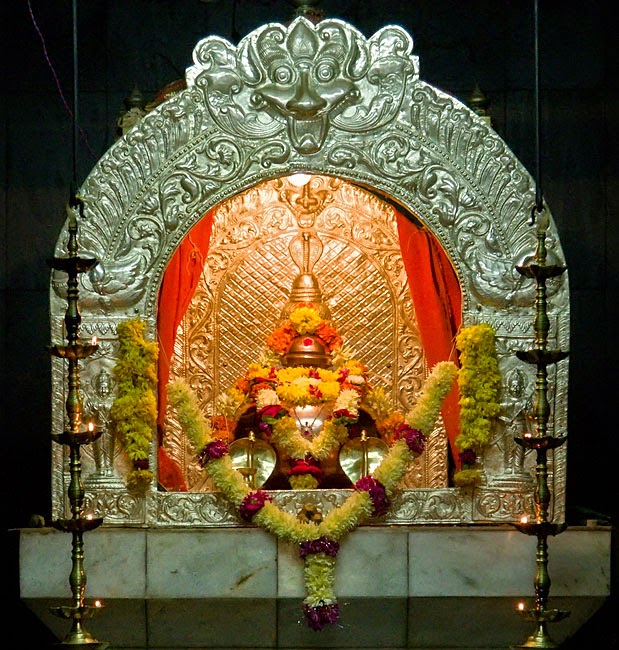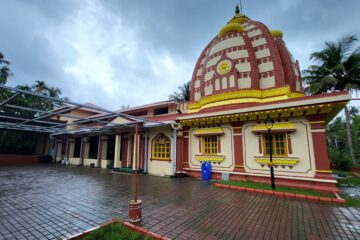Lairai: The Goddess Who Captured My Attention
The name “Lairai” kept coming up often after I moved to Goa. I found myself wondering — who is this goddess? What is her story? These questions kept swirling in my mind. The curiosity only deepened whenever the fair(Jatra) of Goddess Lairai approached. Newspapers would carry large advertisements that immediately caught my eye, especially because of the striking image of the goddess. There was something distinct about her depiction — quite different from how other deities are usually portrayed.
Despite this growing curiosity, I never really got the chance to visit Lairai’s temple. But the more I heard about the grand fair dedicated to her, the more restless I became. I couldn’t wait any longer — I decided that even if I couldn’t make it to the fair, I would definitely visit the temple and seek her blessings.
A Long-Awaited Journey to Shirgao
After many years, we finally set off for Shirgao one day. Traveling from Mapusa through Thivim and Assnora, we eventually reached the village. Shirgao is a small settlement located in the Bicholim taluka. As soon as we entered Assnora, we turned right onto a narrow road leading to Shirgao. The path was scenic — a little bridge over a stream and lush nature flanking both sides made the journey pleasant. Somehow, this village felt different from the typical Goan villages. It lacked that familiar “Goan village vibe” I usually sensed elsewhere. At what seems like the end of the road, stands the temple — as though the path concludes at its feet. But from that point, the road curves right again and continues deeper into the village.
Entering the Abode of the Goddess
Climbing a short flight of steps, we entered the temple. Originally a modest structure, it was expanded into a larger temple around forty years ago. Just inside, there’s a spacious assembly hall — it struck me as particularly large compared to other temples. During the Lairai Jatra, the dhonds (devotees of the goddess) dance in the assembly hall, holding sticks decorated with colourful ribbons. To reach the sanctum, one must climb another set of steps from the assembly hall.
The Unique Structure and Purpose of the Temple’s Inner Room
Most temples in Goa follow a typical layout — an outer assembly hall(sabhamandap) , an inner hall in front of the sanctum called madhyamandap or Chowk, and in between, there is usually a small to moderately sized room known as Antarala. The size of this room varies depending on the temple’s design. In some temples, this space houses musical instruments like drums. In some other temples, it also holds the deity’s Palanquin as in the Vijayadurga, Keri temple or Makhara, as seen in the Shantadurga Kunkallikarin temple in Fatorpa. However, in many temples, this space has been repurposed to include tables and computers for managing donation receipts and administrative work.
In Lairai’s temple, this room is quite spacious. There are staircases on both sides of it that lead up to the inner Chowk area of the temple.
A Glimpse of the Divine — and a Surprising Realization
From there, we entered the main mandap(Chowk). Reaching the sanctum, we offered the oti (traditional offering) and phati (flower garland) to the goddess and turned to face her. I had expected to see the same image of Goddess Lairai that I had often come across in newspapers — wearing a green nine-yard sari, her left leg bent across like in a seated posture, the right leg folded tightly to her stomach, with her right elbow resting on that knee and her palm positioned near her chest.
But what stood before me was entirely different. Instead of an idol, there was a large inverted copper pot, referred to as the kalash — the symbolic representation of the goddess. A square cloth was spread over it, and a small crown was placed on top. The divine presence of Lairai is believed to reside within this pot. Looking at the photographs displayed along the circumambulatory path, I realized that even the image I had seen — of Lairai sitting in that distinctive posture — was a symbolic representation of her presence within the kalash. It is said that this form of the goddess was revealed to a devotee in a dream.
The Beloved Jasmine Offering
Goddess Lairai is especially fond of jasmine buds. Devotees offer garlands made of these fragrant flowers to her. On the day of the annual fair, one jasmine bud from the offerings is placed inside the kalash. Incredibly, this single bud remains fresh and fragrant until the next year’s festival, untouched by time.


Beauty in Simplicity
Of all the temples I’ve visited, this one was perhaps the simplest in design. And yet, that simplicity in no way diminished its spiritual grandeur. The sanctum’s arch (prabhaval) is made of silver, but aside from that, there is no display of opulence — no silver or gold extravagance. The doors are plain, made of wood, and the sanctum itself is not very deep. One step through the doorway, and you’re right there — in the goddess’s presence.
Artistic Elements with Spiritual Significance
The room outside the sanctum is also quite spacious. Above the doorway leading into the sanctum, on the wall, there are paintings of Lord Vishnu in the center, flanked by images of sages on either side. On the left wall next to the door, there’s another depiction of Lord Vishnu with four arms. On the right wall, there’s an image of Lord Ganesha.
Above the outer doorway frame, between two elephants, stands Goddess Lakshmi, and on either side of the frame are the divine gatekeepers, Jaya and Vijaya.
Simplicity That Reflects Devotion
The walls of the Chowk’s side sections display various idols of deities. The pillars and windows on both sides resemble those found in many other temples — simple and unadorned. There is no elaborate wood carving, nor any intricate silver or gold-plated embellishments. And yet, this simplicity deeply appealed to me. It gives the temple a grounded, sincere atmosphere. From this simplicity, one can imagine that the devotees who come here are just as humble and down-to-earth.
A Festival of Fire and Faith
The festival(Jatra) dedicated to Goddess Lairai is one of the most renowned in Goa. A striking ritual marks this celebration — a massive sacred fire is lit in the early hours of the morning, and devotees known as dhonds walk barefoot across the glowing embers. This act of devotion and endurance is the heart of the festival.
These dhonds undergo a strict period of spiritual preparation for nearly a month before the festival. They follow a disciplined vegetarian diet and live away from their homes, observing vows of purity and restraint.
A Village Bound by Sacred Discipline
Another unique feature of this village is that killing or consuming chicken or goats is strictly prohibited. As a result, no one here eats such meat, reflecting a deep-rooted reverence for the sacred space and the goddess. This rule is clearly stated in the temple on a plaque displaying the vows (Ashtak) of Goddess Lairai.
A Promise to Return
All this — the stories shared by the women selling flowers and offerings outside the temple, and the inscription of Goddess Lairai’s vows (Ashtak) displayed inside the temple — left a strong impression on me. After listening about the fair and tale of the goddess Lairai, I made up my mind: I must return someday to witness this extraordinary festival with my own eyes. Let’s see when destiny allows that to happen.
(Note: The halo (prabhaval) of the Goddess is now made of gold, and the sanctum doorway is adorned with intricately carved silver panels.)


